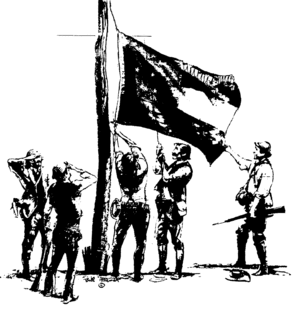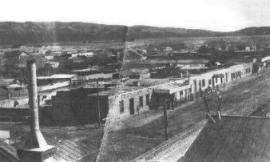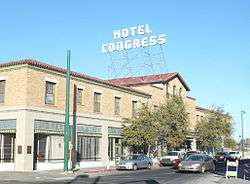History of Tucson, Arizona
The history of Tucson, Arizona, begins thousands of years ago but officially dates back to 1775 when Spanish soldiers founded Presidio San Augustin del Tucson. Since then many different cultures have occupied the city.
Mexican Period
In 1821 Mexico gained independence from Spain. The Mexican Occidente state borders extended further north to include the town of Tucsón. In 1853 the United States acquired from Mexico, in the Gadsden Purchase, a strip of land that included Tucson that would later be used to construct a transcontinental railroad along a deep southern route by the Southern Pacific Railroad.
Before the Capture of Tucson (1846) a Mormon Battalion marched across southern Arizona along the San Pedro River, north of Tucson, there the Mormon soldiers fought the humorously named Battle of the Bulls. The Mormon soldiers encountered wild cattle along the banks of the San Pedro River where several bulls charged their column, tipping over wagons and killing mules and injuring two soldiers. The soldiers shot and killed a number of the wild cattle. The soldiers sarcastically named the encounter the “Battle of the Bulls.” On December 16, 1846, they marched into Tucson. The smaller Mexican garrison of Fort Tucson, quickly fled without conflict. A brief occupation ensued and then the Mormons continued their march to the Pacific.

Early United States and Confederate States Period

In July 1861, after the civil war began, a force of Texan cavalry and Arizonan militia under Lt. Colonel John Baylor conquered the southern New Mexico territory, including Mesilla and Tucson. On August 1, 1861, and the victorious Baylor proclaimed the existence of a Confederate Arizona Territory, which comprised the area defined in the Tucson convention the previous year, with Tucson as its capital. He appointed himself permanent governor.

The proposal to organize the territory was passed by the Confederate Congress in early 1862 and proclaimed by President Jefferson Davis on February 14, 1862. Efforts by the Confederacy to secure control of the region led to the New Mexico Campaign. Later in 1862, Baylor was ousted as governor of the territory by Davis, and the Confederate loss at the Battle of Glorieta Pass forced their retreat. The following month, a small Confederate picket force defeated a Union cavalry patrol north of Tucson at the Battle of Picacho Pass. Despite the Union retreat, Tucson eventually was captured by the California Column.
Later United States Period

Tucson, and all of Arizona, remained part of the New Mexico Territory until February 24, 1863, when the Arizona Organic Act passed the Senate forming the Arizona Territory. In 1867, the territorial capital was moved to Tucson from Prescott, where it remained until 1877. In 1885, the University of Arizona was founded in Tucson – it was situated in the countryside, outside the city limits of the time.
During the territorial and early statehood periods, Tucson was Arizona's largest city and commercial and railroad center,[1] while Phoenix was the seat of state government (beginning in 1889) and agriculture. Between 1910 and 1920, Phoenix surpassed Tucson in population and has continued to outpace Tucson in growth. However, both Tucson and Phoenix have experienced among the highest growth rates in the United States.

Modern Period
By 1900, 7,531 people lived in the city. The population increased gradually to 13,913 in 1910, 20,292 in 1920, and 36,818 in 1940. In 2006 the population of Pima County, in which Tucson is located, passed one million while the City of Tucson's population was 535,000.

Crime
In late January 1934, five members of the Dillinger gang, including John Dillinger, himself, were arrested in Tucson. They were five of the top six names on the FBI's first Public Enemy list. A fire allowed firemen to discover their identity and the police promptly arrested Harry Pierpont, Charles Makley, Russell Clark, Ed Shouse, and Dillinger. The police found the gang in possession of over $25,000 in cash, three sub-machine guns, and five machine guns. Tucson celebrates the historic arrest with an annual "Dillinger Days" festival, the highlight of which is a reenactment.[2][3][4]
Hospitals
In 1919, Lieutenant Neill MacArtan of the Army Medical Corps arrived in Tucson, Arizona, looking for a sanatorium site. He found nearly 700 veterans scattered in squalid conditions throughout the area and commenced a decade's struggle to build a southwestern veterans hospital. Tucson's success is the story of city officials and citizens volunteering, organizing, battling other contenders like Livermore, California, and lobbying Congress. Despite MacArtan's death from tuberculosis in 1922, Veterans Administration Hospital Number 51 opened at Pastime Park in 1928. Many TB sufferers and veterans who had been gassed in World War I and were in need of respiratory therapy came to Tucson after the war because of the clean, dry air.[5]
Chinese
The Chinese came to Tucson with the construction of the Southern Pacific Railroad in 1880. Chinese and Mexican merchants and farmers transcended racial differences to form 'guanxi,' which were relations of friendship and trust. Chinese leased land from Mexicans, operated grocery stores, and aided compatriots attempting to enter the United States from Mexico after the Mexican Revolution in 1910. Chinese merchants supplied General John Pershing's army in its expedition against Pancho Villa. Successful Chinese in Tucson led a viable community based on social integration, friendship, and kinship.[6] A representative community leader was Lee Wee Kwon, who arrived as a refugee from the Mexican civil war in 1917, and was a prominent grocer and community leader until his death in 1965.[7]
World War II
During World War II (1941–45) Mexican-American community organizations were very active in patriotic efforts to support American troops abroad, and made efforts to support the war effort materially and to provide moral support for the young American men fighting the war, especially the young Mexican-American men from local communities. Some of the community projects were cooperative ventures in which members of both the Mexican-American and Anglo communities participated. Most efforts made in the Mexican-American community, however, represented localized American home front activities that were separate from the activities of the Anglo community.[8]
Mexican-American women in Tucson organized to assist their servicemen and the war effort during World War II. An underlying goal of the Spanish-American Mothers and Wives Association was the reinforcement of the woman's role in Spanish-Mexican culture. The organization raised thousands of dollars, wrote letters, and joined in numerous celebrations of their culture and their support for Mexican-American servicemen. Membership reached over 300 during the war and eventually ended its existence in 1976.[9]
See also
References
- ↑ William D. Kalt (2006). Tucson Was a Railroad Town: The Days of Steam in the Big Burg on the Main Line. VTD Rail Pub.
- ↑ "Famous Cases: John Dillinger". FBI.gov. Retrieved 2009-09-21.
- ↑ Webb, Janet (2006-01-08). "The day Tucson corralled Dillinger". Arizona Highways. Retrieved 2009-09-21.
- ↑ Mori, Brian (2009-01-21). "Dillinger Days frenzy coming up". Tucson Citizen. Retrieved 2009-09-21.
- ↑ Alex Jay Kimmelman, "Pastime Park: Tucson's First Veterans' Hospital," Journal of Arizona History 1990 31(1): 19-42,
- ↑ Grace Peña Delgado, "Of Kith and Kin: Land, Leases, and 'Guanxi' in Tucson's Chinese and Mexican Communities, 1880s-1920s," Journal of Arizona History 2005 46(1): 33-54,
- ↑ Li Yang, "Lee Wee Kwon: Chinese Grocer in Tucson, 1917-1965," Journal of Arizona History (2010) 51#1 pp 33-50
- ↑ Christine Marín, "Mexican Americans on the Home Front: Community Organizations in Arizona During World War II," Perspectives in Mexican American Studies 1993 4: 75-92
- ↑ Julie A. Campbell, "Madres Y Esposas: Tucson's Spanish-American Mothers and Wives Association," Journal of Arizona History 1990 31(2): 161-182,